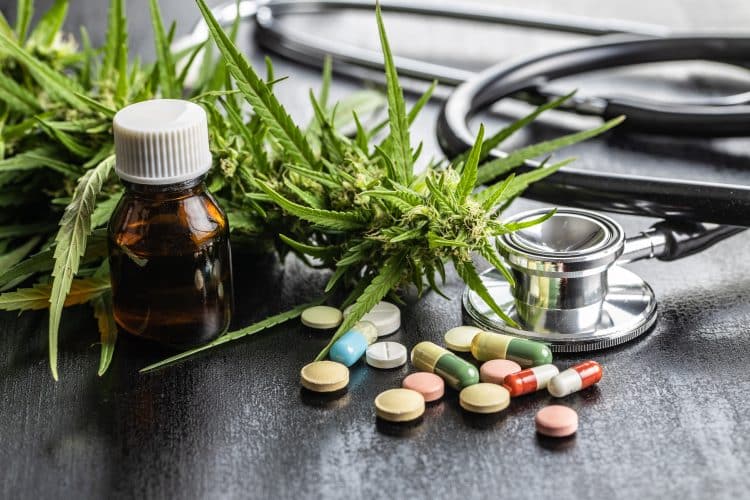Cannabis has become a popular drug in the US and globally in recent years. Cannabis flowers, leaves, stems, and seeds are used to create various products, including tinctures, joints, gummies, beverages, ointments, oils, and much more.
However, despite its mainstream popularity, fewer people are realizing that cannabis has many risks associated with its use, especially younger users. This is partly the case because cannabis sold today is about three times stronger than cannabis sold 25 years ago and the . tetrahydrocannabinol (THC) content is significantly higher.
According to some statistics, one in ten people who consume cannabis consumption. [1] If an individual begins consuming cannabis before the age of 18, the addiction rate is one in six. Addiction aside, there are numerous other risks associated with cannabis use, and we’ve discussed them in this blog.
What Are The Known Risks Associated With Cannabis Consumption?
According to the World Health Organization, 2.5 percent of the world’s population uses cannabis. [2] This percentage equates to 147 million people. One might find this number quite high, considering cannabis and its main psychotropic constituent, THC, remain largely illegal at the federal level despite select US states legalizing its use.
Unfortunately, many of these people don’t realize the risks involved with using cannabis in the short and long term, and with cannabis becoming one of the fastest-growing industries, this is becoming a problem. If you use cannabis or know someone who does, it’s important to be aware of the risks.
Lung Tissue Issues
No matter how cannabis is smoked, it can harm lung tissues and cause damage and scarring to a person’s small blood vessels in their lungs. This is because studies have found that smoke from cannabis has many of the same toxins, carcinogens, and irritants found in tobacco smoke.
These harmful irritants, toxins, and carcinogens can increase the risk of developing bronchitis, smoker cough, and excessive mucus production. [3] In addition, although more research is needed to understand the links between cannabis smoking, lung cancer, and respiratory diseases, there have been findings indicating it could lead to an increased risk of developing these health conditions.
Adverse Mental Health
In recent years, numerous studies have been conducted analyzing cannabis use and its links to adverse mental health. [4] Although researchers aren’t sure why, many of these studies have determined that cannabis use raises an individual’s chances of experiencing clinical depression and can worsen the symptoms of several mental disorders.
In addition, if cannabis is consumed in high doses, it can lead to psychosis, leading to users seeing and experiencing events that aren’t real. During psychosis episodes, people can hurt themselves and others without realizing their actions.
Moreover, it’s been proven that if cannabis is used from a young age, frequently, and for an extended period of time, it can increase an individual’s chances of developing schizophrenia and other psychosis-related mental health conditions. [5]
Problems With Child Development
One study recently revealed that about 20 percent of pregnant women aged 24 and younger screened positive for cannabis. [6] Pregnant women who consume cannabis are at a much higher risk of giving birth to premature babies and having newborns that are underweight.[7]
It has also been uncovered that using cannabis during pregnancy can lead to an increased risk of behavioral and brain problems in babies. Children who have been born to mothers who used cannabis while pregnant also have an increased risk of problems with problem-solving, memory, and attention compared to children not exposed to cannabis.
Raised Heart Rate
A normal heart beats 50 to 70 times a minute, but this can increase to 70 to 120 beats per minute for up to three hours after the effects of cannabis use begin. [8] This increased heart rate places strain on your heart, which can lead to strokes and heart attacks. This is especially true for older adults and those who are already experiencing heart problems.
Increased Accident Involvement
It might be difficult to believe, but cannabis consumption can lead to increased accident involvement. In fact, the one component most frequently reported in impaired driving and accident cases is cannabis. [9]
According to scientists, immediate and long-term exposure to cannabis can impair an individual’s ability to drive safely. Studies have revealed that blood THC levels of 2 to 5 ng per milliliter are associated with substantial driving impairments. [10]
In addition, meta-analysis has proven that involvement in an accident increases by a factor of around two if an individual has used cannabis and drives soon thereafter. Ultimately, smoking, vaping, dabbing, or consuming cannabis increases an individual’s chances of being involved in car accidents and suffering injuries and even death.
The Wrap-Up On The Risks Associated With Cannabis Consumption
Evidently, cannabis consumption carries many risks, which is why it’s usually best to be cautious when using cannabis recreationally or for medical reasons. Now that you know the risks you might face, you have a better understanding of whether or not cannabis use suits your needs.
References:
- Know the risks of marijuana. SAMHSA. (n.d.). https://www.samhsa.gov/marijuana
- World Health Organization. (n.d.). Cannabis. World Health Organization. https://www.who.int/teams/mental-health-and-substance-use/alcohol-drugs-and-addictive-behaviours/drugs-psychoactive/cannabis
- A; C. R. P. (n.d.). Marijuana use and risk of lung cancer: A 40-year cohort study. Cancer causes & control : CCC. https://pubmed.ncbi.nlm.nih.gov/23846283/
- Patton, G. C. (2002). Cannabis Use and Mental Health in Young People: Cohort Study. BMJ, 325(7374), 1195–1198. https://doi.org/10.1136/bmj.325.7374.1195
- Di Forti, M., Sallis, H., Allegri, F., Trotta, A., Ferraro, L., Stilo, S. A., Marconi, A., La Cascia, C., Reis Marques, T., Pariante, C., Dazzan, P., Mondelli, V., Paparelli, A., Kolliakou, A., Prata, D., Gaughran, F., David, A. S., Morgan, C., Stahl, D., & Khondoker, M. (2013). Daily Use, Especially of High-Potency Cannabis, Drives the Earlier Onset of Psychosis in Cannabis Users. Schizophrenia Bulletin, 40(6), 1509–1517. https://doi.org/10.1093/schbul/sbt181
- Young-Wolff, K. C., Tucker, L.-Y., Alexeeff, S., Armstrong, M. A., Conway, A., Weisner, C., & Goler, N. (2017). Trends in Self-reported and Biochemically Tested Marijuana Use Among Pregnant Females in California From 2009-2016. JAMA, 318(24), 2490. https://doi.org/10.1001/jama.2017.17225
- National Academies of Sciences, E. (2017). The Health Effects of Cannabis and Cannabinoids: The Current State of Evidence and Recommendations for Research. In nap.nationalacademies.org. https://nap.nationalacademies.org/catalog/24625/the-health-effects-of-cannabis-and-cannabinoids-the-current-state
- Beckerman, J. (2004, December 8). Anatomy and Circulation of the Heart. WebMD; WebMD. https://www.webmd.com/heart-disease/high-cholesterol-healthy-heart
- Brady, J. E., & Li, G. (2014). Trends in Alcohol and Other Drugs Detected in Fatally Injured Drivers in the United States, 1999-2010. American Journal of Epidemiology, 179(6), 692–699. https://doi.org/10.1093/aje/kwt327
- Hartman, R. L., & Huestis, M. A. (2012). Cannabis Effects on Driving Skills. Clinical Chemistry, 59(3), 478–492. https://doi.org/10.1373/clinchem.2012.194381












